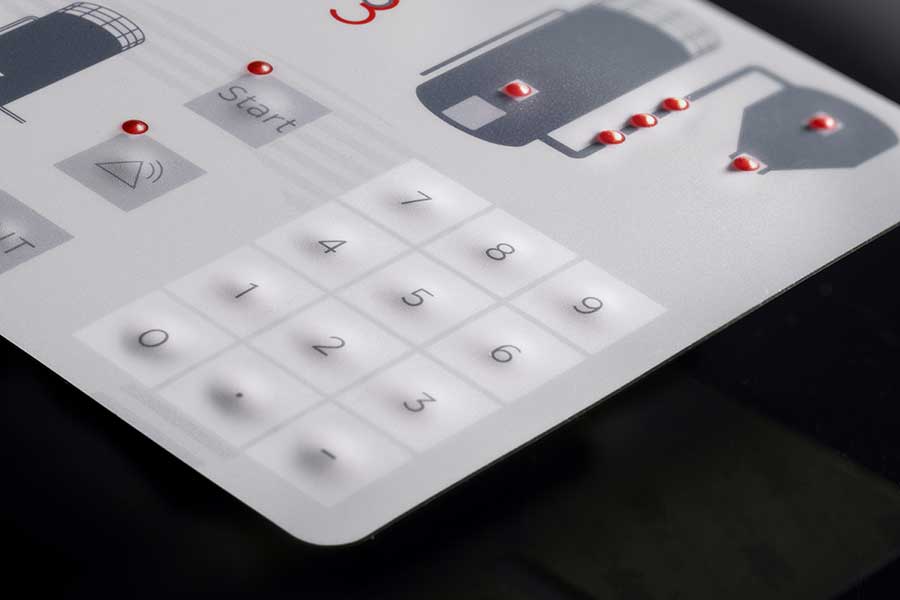Why Picking the Right Membrane Switch Is Essential for Your Item Layout
Why Picking the Right Membrane Switch Is Essential for Your Item Layout
Blog Article
Recognizing the Capability of Membrane Layer Switches for Customer User Interface Gadget
The capability of membrane switches stands for a significant innovation in user interface style, incorporating performance with visual convenience. As industries increasingly prioritize user experience, comprehending the subtleties of membrane layer switch innovation comes to be important.
What Are Membrane Layer Buttons?
Membrane switches are ingenious interface tools that promote user interaction with electronic tools. These functional components are composed of several layers, consisting of a visuals overlay, spacer, and a printed circuit layer. The style enables for a smooth combination right into various digital tools, enhancing both the visual and useful elements of individual interfaces.
Membrane layer switches are commonly employed in a large range of applications, from home home appliances to industrial equipment and medical gadgets. Their construction commonly features a slim account, making them a perfect choice for compact layouts. The tactile comments offered by these switches can be crafted to fulfill certain individual preferences, making certain efficient communication between the customer and the tool.
Toughness is an additional considerable advantage of membrane layer switches, as they are immune to dust, dampness, and chemicals, which improves their life-span in demanding environments. Furthermore, these switches can be tailored in regards to form, dimension, and visuals layout, permitting branding and user-specific attributes. In general, membrane layer changes represent a sensible service for enhancing customer experience in digital devices, incorporating functionality with visual appeal in an efficient manner.
How Membrane Layer Switches Over Work
Operating on an uncomplicated concept, membrane switches use a layered building and construction to register individual input effectively. Each button includes numerous layers, including a published circuit layer, a spacer layer, and a leading graphic layer, which are made to collaborate effortlessly. When a user presses the top layer, it presses the spacer layer, bringing the conductive elements of the circuit layer into call with each other.
This get in touch with creates a shut circuit, indicating the tool to perform a details function. The design enables for various setups, consisting of responsive responses, which can boost the user experience by giving a physical feeling upon activation. The materials used in membrane switches frequently include flexible substratums, such as polyester or polycarbonate, which guarantee longevity and resilience against deterioration.

Secret Benefits of Membrane Switches

Another substantial benefit is their density. Membrane buttons are thin and lightweight, which enables producers to conserve area in their devices without giving up functionality. This attribute is especially useful in applications where weight and quantity are essential factors to consider.
Additionally, membrane layer switches are immune to dust, wetness, and chemicals, improving their sturdiness. This resilience expands their life-span and reduces the demand for constant replacements, resulting in cost savings over time.
Furthermore, the responsive responses provided by membrane layer switches can be optimized to improve customer interaction. They can consist of attributes such as elevated switches or audible clicks, enhancing use and user experience.
Applications Throughout Industries
User interface tools utilizing membrane buttons prevail in a broad variety of sectors, showcasing their versatility and performance. Membrane Switch. In the medical field, membrane layer switches are indispensable to gadgets such as analysis devices and person surveillance systems, where their sturdiness and convenience of cleansing are crucial for preserving hygiene requirements. Likewise, in the auto sector, these switches are utilized in dashboard controls and infotainment systems, offering a streamlined and contemporary user interface for individuals.
Additionally, the customer electronic devices sector take advantage of membrane layer switches in home appliances and handheld devices, where compact layout and user-friendly user interfaces improve individual experience. Industrial applications likewise take advantage of membrane switches for control board in equipment and automation systems, emphasizing their robustness and resistance to extreme environments.
In the aerospace and defense sectors, membrane layer switches are utilized in cabin controls and tools, where dependability and performance under extreme conditions are extremely important. In addition, the pc gaming sector significantly integrates membrane buttons in controllers and game devices, adding to an interesting user experience. On the whole, the adaptability of membrane changes enables their widespread usage across numerous sectors, emphasizing their relevance in contemporary interface style.
Future Fads in Membrane Layer Switch Over Modern Technology

In addition, making use of innovative materials, such as polycarbonate and polyester movies, is anticipated to increase, providing improved longevity and resistance to environmental stressors. These materials add to the general durability of membrane layer buttons, making them ideal for harsher industrial applications.
Furthermore, the incorporation of smart innovation, dig this including IoT connectivity, will certainly enable membrane switches to connect with other gadgets and systems, facilitating an extra interactive customer experience. This fad aligns with the growing need for clever tools throughout numerous fields, from medical care to customer electronic devices.
Last but not least, modification alternatives are prepared for to increase, permitting makers to produce bespoke options tailored to particular individual demands and choices. These growths will certainly place membrane layer buttons as necessary elements in the evolution of individual interface innovation.
Final Thought
In conclusion, membrane changes stand for a critical development in customer interface technology, supplying a dependable and functional service for varied digital applications. As developments in product scientific research and my review here touch noticing modern technologies continue, the performance and applicability of membrane layer buttons are expected to broaden, reinforcing their significance in contemporary digital tools.
Report this page